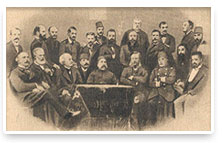Convention of Constantinople facts for kids

Representatives of each respective country
|
|
| Type | Multilateral trade treaty |
|---|---|
| Drafted | 2 March 1888 |
| Signed | 29 October 1888 |
| Location | Constantinople, Ottoman Empire |
| Effective | 8 April 1904 |
| Expiration | N/A |
| Signatories | |
| Depositary | Ottoman Empire |
| Language | French |
The Convention of Constantinople is an important treaty about how the Suez Canal in Egypt should be used. A treaty is like a formal agreement between countries. This one was signed on October 29, 1888. Many powerful countries signed it, including the United Kingdom, Germany, Austria-Hungary, Spain, France, Italy, the Netherlands, the Russian Empire, and the Ottoman Empire.
The Suez Canal is a man-made waterway that connects the Mediterranean Sea to the Red Sea. It makes travel by ship much shorter, as ships don't have to go all the way around Africa. The treaty made sure that ships from all countries could use the canal freely, whether it was a time of war or peace. For many years, the United Kingdom had a strong influence over the canal. Later, in 1956, the Egyptian government took control of the Suez Canal Company. The canal was sometimes closed during wars between Egypt and Israel.
Contents
How the Treaty Came About
Egypt's Financial Troubles
In 1875, Egypt faced money problems. The ruler of Egypt, called the Khedive Isma'il the Magnificent, had to sell Egypt's shares in the company that managed the Suez Canal. The United Kingdom bought these shares. This gave Britain a big stake in the canal.
A few years later, in 1879, other powerful European countries, including Britain, forced Isma'il to step down. His son, Tewfik Pasha, became the new Khedive. But many Egyptians were unhappy with Tewfik's rule. This led to a rebellion by army officers in 1881, known as the Orabi Revolt.
Britain Takes Control
The British worried that the rebellion might threaten their use of the Suez Canal. So, they sent their military to help Tewfik. Britain won the Anglo–Egyptian War. This victory meant that Britain gained control over Egypt, including the Suez Canal.
France, which had helped build the canal and whose investors still owned most of the Suez Canal Company, wanted to reduce Britain's power. France tried to get other European countries to agree that the canal should be managed by everyone, not just Britain.
Making the Treaty
Britain and France eventually agreed to make the canal neutral through a treaty. This meant it would be open to all ships.
The treaty had some tricky parts:
- Article I said that all ships could pass through the canal during both war and peace.
- Article X allowed the Egyptian government to take actions to protect Egypt and keep order.
These two rules sometimes caused problems. For example, during the Second World War, Britain used Article X to stop ships from countries they were fighting (the Axis powers) from using the canal. Later, Egypt used it to stop Israeli ships after 1948, when a state of war began between the two countries.
When the Treaty Started Working
The British government didn't fully agree to the treaty at first. They had some serious concerns because they were occupying Egypt at the time. They worried the treaty might limit their actions while their forces were in Egypt.
France accepted this concern, but it meant the treaty wasn't fully active right away. It was like an "academic declaration" – a good idea, but not fully in force. The treaty only truly began to work in 1904. This happened after Britain and France signed a new agreement called the Entente Cordiale. This agreement helped improve relations between the two countries.
The Canal During Wars
World War I
When the First World War started in 1914, Egypt said the canal would be open to all ships. However, Britain soon took more control. They removed the Egyptian ruler, Abbas Hilmi II, and made Egypt a British protectorate. After that, Britain stopped ships from the Central Powers (their enemies in the war) from using the canal.
Later Conflicts
On June 5, 1967, during the Six-Day War, Egypt closed the canal to Israel. The canal stayed closed for many years through other conflicts, like the War of Attrition (1968-1970) and the October War (1973). It finally reopened on June 10, 1975.
Today, a group of 14 countries called the Multinational Force and Observers (MFO) helps make sure the peace treaty rules for the canal are followed. The canal is owned and managed by the Suez Canal Authority of Egypt. According to international rules, Egypt cannot stop any ship from passing through the canal unless there is a war between Egypt and that ship's country.
See also
 In Spanish: Convención de Constantinopla para niños
In Spanish: Convención de Constantinopla para niños

